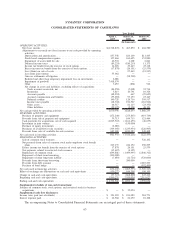Symantec 2009 Annual Report Download - page 127
Download and view the complete annual report
Please find page 127 of the 2009 Symantec annual report below. You can navigate through the pages in the report by either clicking on the pages listed below, or by using the keyword search tool below to find specific information within the annual report.
and losses on the contracts are intended to offset the gains and losses on the underlying transactions. Both the
changes in fair value of outstanding forward contracts and realized foreign exchange gains and losses are included
in Other income, net. Contract fair values are determined based upon quoted prices for identical foreign currencies
in other markets from brokers. For each fiscal year presented in this report, outstanding derivative contracts and the
related gains or losses were not material.
Convertible senior notes, note hedge and revolving credit facility. Our convertible senior notes were
recorded at cost based upon par value at issuance. Debt issuance costs were recorded in Other long-term assets
and are being amortized to Interest expense using the effective interest method over five years for the 0.75% Notes
and seven years for the 1.00% Notes. In conjunction with the issuance of the notes, we obtained hedges which would
provide us with the option to purchase additional common shares at a fixed price from the note holders after
conversion. The cost incurred in connection with the note hedge transaction, net of the related tax benefit and the
proceeds from the sale of warrants, was included as a net reduction in Additional paid-in capital. Borrowings under
our $1 billion senior unsecured revolving credit facility are generally recognized at cost plus accrued interest based
upon stated interest rates.
Trade Accounts Receivable
Trade accounts receivable are recorded at the invoiced amount and are not interest bearing. We maintain an
allowance for doubtful accounts to reserve for potentially uncollectible trade receivables. Additions to the
allowance for doubtful accounts are recorded as General and administrative expenses. We review our trade
receivables by aging category to identify specific customers with known disputes or collectibility issues. In
addition, we maintain an allowance for all other receivables not included in the specific reserve by applying specific
percentages of projected uncollectible receivables to the various aging categories. In determining these percentages,
we analyze our historical collection experience and current economic trends. We exercise judgment when
determining the adequacy of these reserves as we evaluate historical bad debt trends, general economic conditions
in the U.S. and internationally, and changes in customer financial conditions. We also offset deferred revenue
against accounts receivable when channel inventories are in excess of specified levels and for transactions where
collection of a receivable is not considered probable. The following table summarizes trade accounts receivable, net
of allowances and reserves for the periods ending:
April 3,
2009
March 28,
2008
Year Ended
(In thousands)
Trade accounts receivable, net:
Receivables ............................................... $858,001 $781,514
Less: allowance for doubtful accounts ........................... (8,863) (8,915)
Less: reserve for product returns ............................... (12,128) (14,399)
Trade accounts receivable, net: ............................... $837,010 $758,200
Equity Method Investments
We account for the Huawei-Symantec, Inc. joint venture (“joint venture”) under the equity method. Under the
equity method, we record our proportionate share of the joint venture’s net loss, based on the quarterly financial
statements of the joint venture. We record our proportionate share of the net loss one quarter in arrears. In
determining our share of the joint venture’s net loss, we adjust the joint venture’s reported results to recognize the
amortization expense associated with the difference between the carrying value of our investment in the joint
venture and our proportionate share of the book value of the joint venture. Our proportionate share of net losses is
included in the Loss from joint venture. See Note 7 for details.
67
SYMANTEC CORPORATION
Notes to Consolidated Financial Statements — (Continued)
























